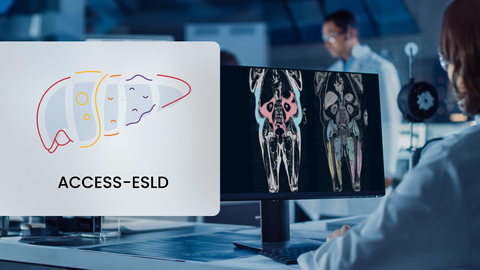The comprehensive ACCESS-ESLD study aims to validate novel biomarkers and imaging techniques for screening of hepatocellular carcinoma and sarcopenia in liver cirrhosis patients using a rapid, non-invasive clinical surveillance methodology, powered by AMRA’s MRI-based body composition technology
AMRA Medical, a health informatics and precision medicine company that is pioneering body composition research through gold-standard MRI-based analysis platforms, in collaboration with Linköping University, is pleased to announce the completion of baseline enrollment for the innovative ACCESS-ESLD (A Rapid, Non-invasive, Clinical Surveillance for CachExia, Sarcopenia, Portal HypertenSion, and Hepatocellular Carcinoma in End-Stage Liver Disease) study. The nationally-comprised study population includes 150 liver cirrhosis patients aged 18 and up, with no liver transplant history or contraindications to performing an MRI examination, enrolled from one of three Swedish liver care clinics located in Linköping, Eksjö, or Jönköping. Over a duration of 2 years, patients will be assessed every 6 months with a comprehensive clinical examination and a whole-body MRI examination.
This press release features multimedia. View the full release here: https://www.businesswire.com/news/home/20240425020008/en/

A rapid, non-invasive, clinical surveillance for CachExia, sarcopenia, portal hypertension, and hepatocellular carcinoma in end-stage liver disease: the ACCESS-ESLD study protocol (Photo: Business Wire)
ACCESS-ESLD will characterize body composition using AMRA’s proprietary MRI-based health informatics platform to assess muscle volume (MV) and muscle fat infiltration (MFI), as well as measures of portal blood flow, liver stiffness, and spleen volume. These measures will be used to identify and validate risk factors and biomarkers that indicate current disease severity and predict future liver-related clinical events in patients with liver cirrhosis. AMRA’s muscle volume (MV) and muscle fat infiltration (MFI) measures have previously been shown to independently predict all-cause mortality1 and comorbid vulnerability2 in patients with fatty liver disease.
The primary objective of the study will be to determine whether or not changes in patient MV and MFI, either individually or in combination, can predict onset of events related to end-stage liver disease. Additionally, the investigators hope to identify predictors of mortality, assess non-invasive markers for portal hypertension, and evaluate how muscle composition and combined body profile assessments impact diagnosis, physical function and quality of life in patients with liver disease. The full manuscript detailing the ACCESS-ESLD study design and objectives was recently published in the journal BMC Gastroenterology in late 2023.
An indication that poses a significant clinical burden and unmet need for patients and providers, liver cirrhosis was historically centered around treatment of complications after they present in patients. The study investigators hope that the findings of ACCESS-ESLD will continue the shift in management of liver disease towards employing more of a preemptive approach, by developing ways to monitor disease progression and severity while also identifying novel biomarkers to help predict comorbid diseases/complications in patients.
“In Sweden, there’s a noticeable rise in liver disease, a condition often shadowed by social stigma and left neglected.” says Mattias Ekstedt at the department of health, medicine and caring sciences (HMV) at Linköping University. “The ACCESS-ESLD study promises to enhance our capabilities in detecting and tracking the progress of individuals living with liver disease, offering hope for better understanding and management of this health challenge.”
AMRA’s significant involvement in a hallmark study in the liver disease space such as this one embodies the company’s commitment to advancing both research and clinical care. Learn more about AMRA Medical and how the use of MRI-based body composition analysis is advancing disease research in liver disease and beyond.
References
1. Linge J, Nasr P, Sanyal A.J, Leinhard O.D, Ekstedt M, Adverse muscle composition is a significant risk factor for all-cause mortality in NAFLD, JHEP Reports, 2022: 5(3); 100663. https://doi.org/10.1016/j.jhepr.2022.100663
2. Linge J, Ekstedt M, Leinhard O.D, Adverse muscle composition is linked to poor functional performance and metabolic comorbidities in NAFLD. JHEP Reports, 2021: 3(1);100197. https://doi.org/10.1016/j.jhepr.2020.100197
About AMRA Medical
AMRA Medical is a health informatics and precision medicine company that is pioneering body composition analysis, providing cutting-edge solutions to advance both clinical research and patient care initiatives. AMRA's gold-standard technology delivers multiple fat and muscle biomarkers - derived simply from rapid whole-body MRI scans. AMRA is committed to driving transformative care and simplifying vital decision-making in both research and clinical care settings by offering support services via their innovative platform.
Learn more about AMRA Medical’s MRI-based solutions at https://amramedical.com/solutions, or connect with our team of experts for a detailed discussion at info@amramedical.com.
Follow AMRA on LinkedIn for the latest updates in body composition and precision medicine.
View source version on businesswire.com: https://www.businesswire.com/news/home/20240425020008/en/
Contacts
AMRA Medical
Marie Börjesson, VP Brand & Marketing
0046 70 628 1977
marie.borjesson@amramedical.com